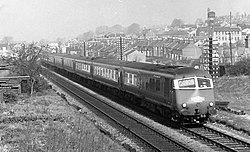InterCity 125
The InterCity 125 is the brand name of British Rail's High Speed Train (HST) fleet. The InterCity 125 train is made up of two locomotives, one at each end of a fixed formation of carriages, and is capable of 125 mph in regular service. British Rail initially used the fleet on the Great Western Main Line, on the East Coast Main Line, on the Cross Country Route and latterly on the Midland Main Line, serving destinations such as London, Bristol, Edinburgh, as far south as Penzance and as far north as Aberdeen and Inverness. The InterCity 125 took the world record for the fastest diesel-powered train, when it was recorded at an absolute maximum speed of 148 mph (238 km/h) during 1987.[1][2] From 2017, most have been replaced by the British Rail Class 800 or similar types of train.[3]
| InterCity 125 | |

| |
| HST Powercar 43316 at London King's Cross | |
| Power type | Diesel |
|---|---|
| Build date | 1976–1982 |
| Top speed | 148 mph (238 km/h) |
| Disposition | still in service |
Gallery
A BR HST set near Chesterfield
A East Midlands Trains liveried HST in Leicester
A East Coast HST at Grahamston in Scotland
InterCity 125 Media
The Blue Pullmans, which were in service between 1960 and 1973, are often seen as forerunners of the HSTs.
Class 252 prototype HST at Weston-super-Mare in 1975
An InterCity 125 about to depart Manchester Piccadilly in 1986
The cab fronts of three HSTs at London King's Cross in 1981
An HST set in the later InterCity livery at Leamington Spa in 1992
First Great Western HST passing Old Oak Common Train Maintenance Depot in 2007
Highland Chieftain InterCity 125 arriving at Haymarket in 2016
References
- ↑ "Rail Timeline". BBC News Online (BBC). http://news.bbc.co.uk/1/shared/spl/hi/programmes/the_day_britain_stopped/timelines/rail/html/1970s.stm. Retrieved 2008-04-07.
- ↑ Hollowood, Russell (2006-03-16). "The little train that could". BBC News Online (BBC). http://news.bbc.co.uk/1/hi/magazine/4812304.stm. Retrieved 2008-04-07.
- ↑ Government gives green light for more state-of-the-art intercity trains, Department for Transport, 18 July 2013













